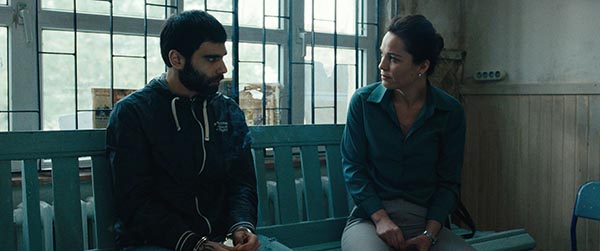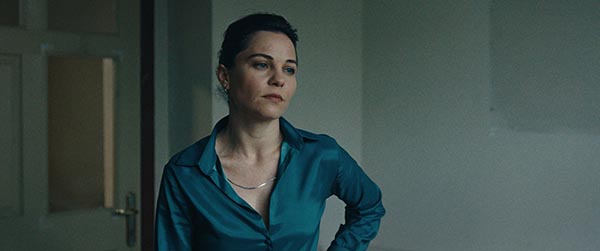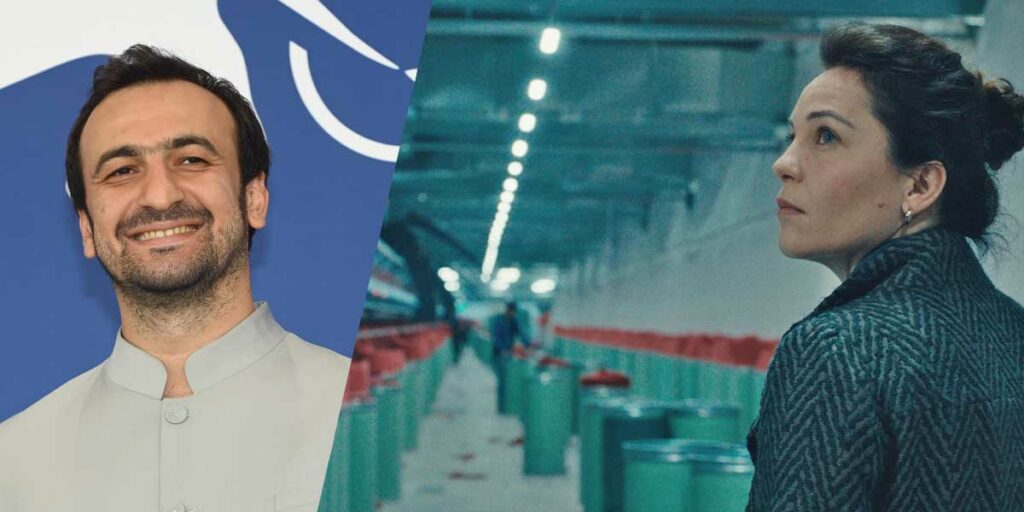We sit down for an interview with writer-director Selman Nacar to discuss Hesitation Wound, his day-in-the-life Turkish courtroom drama.
The Orizzonti strand at the Venice Film Festival is dedicated to highlighting the most interesting up-and-coming voices in world cinema. On the evidence of Hesitation Wound (Tereddüt Çizgisi), writer-director Selman Nacar is a voice worth hearing.
Hesitation Wound centres on Canan (Tülin Özen), a defence lawyer living and working in the Turkish city of Usak. Her attention is torn between her mother’s hospital bed and the courtroom, where she’s defending a man accused of murder. As the day goes on, Canan finds herself confronted with grave moral conundrums, as high-pressure decisions are required to help both her mother and her client.
Hesitation Wound is a brilliantly efficient (It runs just 84 minutes) and intelligent examination of justice, morality and our inability to exercise control over our lives. We sat down for an interview with Selman Nacar the day after its premiere at the Venice Film Festival to discuss how it feels to finally present the film to an audience, Özen’s magnificent lead performance, and how to keep a film brief and to the point.
Selman Nacar on Hesitation Wound’s premiere at the Venice Film Festival
How are you today after the big premiere yesterday?
Selman Nacar: I’m relieved in a way, you know? But at the same time, not exactly. We have been working on this almost three years, and the moment that you share with the audience, it’s a really interesting feeling.
Do you feel like when you’ve shown the film to the audience, that it’s no longer yours? That you’ve had to give it over to them?
S. N.: Definitely. But that doesn’t happen in the first screening: it takes a bit of time. You kind of feel the film is yours, but there comes a point when audiences start to watch it enough, and you understand, “Okay, this is no longer mine”, you know? It’s from there that I can’t do anything.
What I love about the film is that, for all the drama that’s going on, I think it’s a relatively simple plot. Where did that come from?
S. N.: Firstly, deciding to make a film is not easy, because for at least three years, or even more than that, it’s your life.
I studied law, and I’ve always been interested in this kind of topic: justice, crime, and reality. So I’ve had a chance to think about these kind of issues before. But that’s not enough, of course. One of the important things for me was the character, because I love telling the story from a character’s point of view. This character, Canan, is in between many things, and feels stuck, in a way: she’s in between her professional and personal life. She was living in the big city, but had to come back to a small city. She doesn’t fit in somehow: she has a strong personality, but she’s surrounded by many men in a strong, male-centric world. Her feeling of being stuck was really something that I wanted to discover.

But I also wanted to make a film that only took place in public locations. There is no private location in Hesitation Wound. We have a courthouse, a hospital, a post office, the jail, the streets, but no private place. The only kind of private place Canan’s car, which doesn’t even belong to her, so it’s like she doesn’t have anywhere to go that belongs to her. She lives in the hospital with her mother, then goes to court. This idea of public places was really exciting for me to discover, because there’s a feeling that I think everyone more or less feels when you go there. You go to the hospital because you’re sick, but you see someone who’s more sick than you, and it gives you a very interesting feeling. If you go to jail or court for any reason, and you see some people fighting or some people who are being brought to the jail. There’s a feeling when you interact with public places, so I wanted to also discover that.
Lastly, I love to try to understand how systems work, or more importantly, don’t work. That’s why I love discovering, and questioning how the characters are connected with the city itself. In this case, there’s a crime. But is it just related to these people? Or is it related with everyone in this city? So if the system is not working, how responsible is each person? I love to try to discover these connections.
Selman Nacar on how he became a filmmaker
As you mentioned previously, you studied law. But now, you lecture in Columbia University on filmmaking. How did you come to make that leap from law into filmmaking?
Selman Nacar: Even when I was studying law, I always felt that I wanted to make something. I didn’t know what it was. I was always writing, I always had a connection with it, and I thought maybe I was just going to write.
I grew up in a small city – It’s actually the city where we shot Hesitation Wound! – and where I was from, there was no theatre. I’ve never even had a chance to go see a film on the big screen, when I was a child. No film has ever been shot in that city, until I shot this one. That’s why I never had the idea about filmmaking before: I just knew the films.
When I was studying law, I remembered the moment that I saw a film set on street: it’s was like, falling in love, because it had everything my personality wanted. There’s writing, and there’s a philosophy behind it, but you cannot do it alone. You need people, there is an organisation and collaboration. The moment I met with the camera was when I took a class when I was studying law, and I saw what a camera could do visually: I was fascinated. I said, “I want to make films,” but I didn’t have enough courage to even share this with my girlfriend at that time, because it was such a big thing. And it was not easy for me to share: I was shy about it.
But then you reach the moment when you understand that “I cannot do this as a hobby. I want to do it for the whole of my life.”
Selman Necar on making Hesitation Wound
This is your second feature. What did you find were the biggest differences between making you first and your second films?
Selman Nacar: For me, while creating the story, the biggest change was with the characters, because both films are from a character’s point of view. In my first film (Between Two Dawns, released in 2021), the character was someone who is reacting to what’s happening around him, and we are looking at the film’s events from the outside in, trying to understand and to observe his reactions.
In Hesitation Wound, I wanted to create a character that we could look at from the inside out – a character who is really proactive and causing things, and shaping and leading these things on her own. So, this character difference changed everything. It changed the rhythm and the feeling, and it affected every aspect of the film.
Personally, of course, I think I was more experienced shooting the second film. I was happy with Between Two Dawns, but in this film, I’m so happy with the casting process, even the smallest roles: I got the chance to choose the right person, and work on it. We also had more time to work on the mise-en-scene and the background acting in this one. I think it all comes with experience.

How did Tülin Özen come to the project?
S. N.: She’s a well known actress in Turkey. I knew of her, but I was not necessarily thinking of her for the role. I met so many people and did many auditions, but when I talked to her, her approach and her understanding of the character really affected me. Not only is she a great actress and a great person, but I also trusted her and knew that we could collaborate on this character. We spent one year preparing: we went to courthouses and law offices, and we observed many things. In the film, we tell you about the character, even though this is just two days in her story. But what happened before, and before? And what is she likely to do after? We knew every detail of the character, and we also did a lot of physical rehearsal too. So when she came to the set, she was already Canan. That gave us an opportunity to work only on the analysis on set, and really create this character together.
A lot of people complain these days that films are just too long for what they offer. Was it always in mind that you would keep the film under 90 minutes?
S. N.: I never thought of it that way. If a film really needs to be long, it should be long; if it needs to be shorter because of the rhythm or other reasons, it should be shorter. I like really trying to understand the emotional rhythm of many things while deciding. Personally, I don’t care if it ends up being 85 minutes long. Another difference between my first and second films is that, on the first film, I was merciless. I cut everything that shouldn’t be there. But in this film, I was like, if just one frame doesn’t need to be there, it shouldn’t be there. Because I love to tell the story economically in every respect, and I kind of feel responsible for every frame that’s in the film. Also, my writing pace and shooting pace are similar, so I knew that it was going to be around this length: it wasn’t surprising.
How long was the first cut of Hesitation Wound?
S. N.: About two hours.
Did you find it difficult to trim it down?
S. N.: Of course, it was difficult. Sometimes you work on something so hard, and you spend your days on it. But then you need to cut it, and it’s so difficult to make that decision. At the same time, sometimes you don’t know what is right or wrong: you just try. But I really got an advantage of doing some test screenings to different people from different backgrounds, just to understand how the audience was reacting to the film, and I also showed it to some friends. I trust audience reactions: they know the reason why they have a reaction, and I then try to understand why this reaction is happening. It could be related to a scene, or to the scene before: you need to understand the connection, and it’s difficult to find it at first. But when I do, I know what we need to cut. I do it, but of course it’s not easy.
Selman Nacar on how Hesitation Wound’s themes, and what happens next
I wanted to ask more about the themes of the film. Broader audiences here and in other parts of the world might be vaguely aware of events that are happening politically in Turkey. Is there a point about Turkey, or other themes or ideas that you’d like people to come away from the film with?
Selman Nacar: It’s not only about Turkey today, but I think it’s about the issue of justice: it’s a historical thing. There’s a time and place in the film, but it’s not defined so much: what we see could happen more or less any time, or in any place. I wanted to create this feeling, because when the system is not working, or is corrupted, the film is trying to understand if you can be innocent, or if you also start playing a game. If there is crime, who is responsible for that? Is it only that person or do we have responsibilities in order to understand it in the background? For example, the city represents the country, of course, but it could represent many things, including society itself. I hope that, even though people don’t know Turkey or a certain city, they can empathise and have a reaction. Nowadays, in the world, everywhere is kind of going crazy in a very strange way. It’s not a good thing, but I believe it’s happening everywhere: people can empathise in some way.
What’s next for you, and for Hesitation Wound?
S. N.: Of course, the film’s journey is just starting. I hope it’s going to be an efficient, beautiful journey for the film. We’re really happy to open at Venice, and we will see what’s going to happen next. I’m also writing and directing a series that I created for Netflix Turkey, and I’ve been working on that for a long time. Meanwhile, I’m working on an idea for my third film, that is in English.
This interview has been edited for length and clarity.
Hesitation Wound (Tereddüt Çizgisi) premiered at the Venice Film Festival on September 4, 2023.

